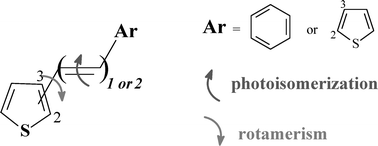Effect of thienyl groups on the photoisomerization and rotamerism of symmetric and asymmetric diaryl-ethenes and diaryl-butadienes†
Abstract
Five symmetric (bis-substituted) and asymmetric (mono-substituted) analogues of

* Corresponding authors
a
Dipartimento di Chimica, Università di Perugia, 06123 Perugia, Italy
E-mail:
mazzucat@unipg.it
b Dipartimento di Scienze Chimiche, Università di Padova, 35131 Padova, Italy
Five symmetric (bis-substituted) and asymmetric (mono-substituted) analogues of

 Please wait while we load your content...
Something went wrong. Try again?
Please wait while we load your content...
Something went wrong. Try again?
G. Bartocci, G. Galiazzo, G. Ginocchietti, U. Mazzucato and A. Spalletti, Photochem. Photobiol. Sci., 2004, 3, 870 DOI: 10.1039/B408241A
To request permission to reproduce material from this article, please go to the Copyright Clearance Center request page.
If you are an author contributing to an RSC publication, you do not need to request permission provided correct acknowledgement is given.
If you are the author of this article, you do not need to request permission to reproduce figures and diagrams provided correct acknowledgement is given. If you want to reproduce the whole article in a third-party publication (excluding your thesis/dissertation for which permission is not required) please go to the Copyright Clearance Center request page.
Read more about how to correctly acknowledge RSC content.
 Fetching data from CrossRef.
Fetching data from CrossRef.
This may take some time to load.
Loading related content
